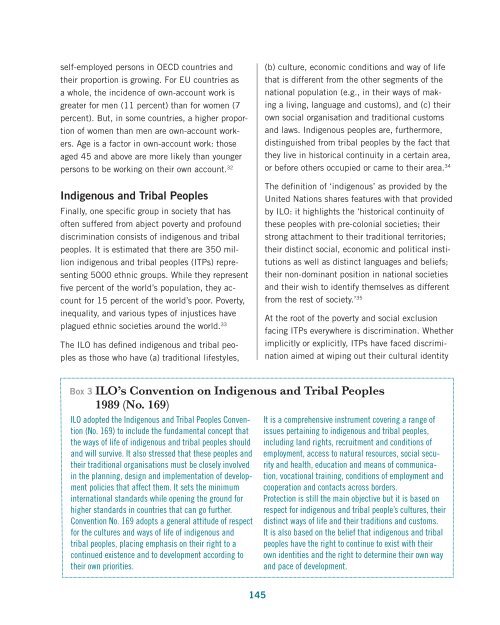Download the file - United Nations Rule of Law
Download the file - United Nations Rule of Law
Download the file - United Nations Rule of Law
Create successful ePaper yourself
Turn your PDF publications into a flip-book with our unique Google optimized e-Paper software.
self-employed persons in OECD countries and<strong>the</strong>ir proportion is growing. For EU countries asa whole, <strong>the</strong> incidence <strong>of</strong> own-account work isgreater for men (11 percent) than for women (7percent). But, in some countries, a higher proportion<strong>of</strong> women than men are own-account workers.Age is a factor in own-account work: thoseaged 45 and above are more likely than youngerpersons to be working on <strong>the</strong>ir own account. 32Indigenous and Tribal PeoplesFinally, one specific group in society that has<strong>of</strong>ten suffered from abject poverty and pr<strong>of</strong>ounddiscrimination consists <strong>of</strong> indigenous and tribalpeoples. It is estimated that <strong>the</strong>re are 350 millionindigenous and tribal peoples (ITPs) representing5000 ethnic groups. While <strong>the</strong>y representfive percent <strong>of</strong> <strong>the</strong> world’s population, <strong>the</strong>y accountfor 15 percent <strong>of</strong> <strong>the</strong> world’s poor. Poverty,inequality, and various types <strong>of</strong> injustices haveplagued ethnic societies around <strong>the</strong> world. 33The ILO has defined indigenous and tribal peoplesas those who have (a) traditional lifestyles,(b) culture, economic conditions and way <strong>of</strong> lifethat is different from <strong>the</strong> o<strong>the</strong>r segments <strong>of</strong> <strong>the</strong>national population (e.g., in <strong>the</strong>ir ways <strong>of</strong> makinga living, language and customs), and (c) <strong>the</strong>irown social organisation and traditional customsand laws. Indigenous peoples are, fur<strong>the</strong>rmore,distinguished from tribal peoples by <strong>the</strong> fact that<strong>the</strong>y live in historical continuity in a certain area,or before o<strong>the</strong>rs occupied or came to <strong>the</strong>ir area. 34The definition <strong>of</strong> ‘indigenous’ as provided by <strong>the</strong><strong>United</strong> <strong>Nations</strong> shares features with that providedby ILO: it highlights <strong>the</strong> ‘historical continuity <strong>of</strong><strong>the</strong>se peoples with pre-colonial societies; <strong>the</strong>irstrong attachment to <strong>the</strong>ir traditional territories;<strong>the</strong>ir distinct social, economic and political institutionsas well as distinct languages and beliefs;<strong>the</strong>ir non-dominant position in national societiesand <strong>the</strong>ir wish to identify <strong>the</strong>mselves as differentfrom <strong>the</strong> rest <strong>of</strong> society.’ 35At <strong>the</strong> root <strong>of</strong> <strong>the</strong> poverty and social exclusionfacing ITPs everywhere is discrimination. Whe<strong>the</strong>rimplicitly or explicitly, ITPs have faced discriminationaimed at wiping out <strong>the</strong>ir cultural identityBox 3 ILO’s Convention on Indigenous and Tribal Peoples1989 (No. 169)ILO adopted <strong>the</strong> Indigenous and Tribal Peoples Convention(No. 169) to include <strong>the</strong> fundamental concept that<strong>the</strong> ways <strong>of</strong> life <strong>of</strong> indigenous and tribal peoples shouldand will survive. It also stressed that <strong>the</strong>se peoples and<strong>the</strong>ir traditional organisations must be closely involvedin <strong>the</strong> planning, design and implementation <strong>of</strong> developmentpolicies that affect <strong>the</strong>m. It sets <strong>the</strong> minimuminternational standards while opening <strong>the</strong> ground forhigher standards in countries that can go fur<strong>the</strong>r.Convention No. 169 adopts a general attitude <strong>of</strong> respectfor <strong>the</strong> cultures and ways <strong>of</strong> life <strong>of</strong> indigenous andtribal peoples, placing emphasis on <strong>the</strong>ir right to acontinued existence and to development according to<strong>the</strong>ir own priorities.It is a comprehensive instrument covering a range <strong>of</strong>issues pertaining to indigenous and tribal peoples,including land rights, recruitment and conditions <strong>of</strong>employment, access to natural resources, social securityand health, education and means <strong>of</strong> communication,vocational training, conditions <strong>of</strong> employment andcooperation and contacts across borders.Protection is still <strong>the</strong> main objective but it is based onrespect for indigenous and tribal people’s cultures, <strong>the</strong>irdistinct ways <strong>of</strong> life and <strong>the</strong>ir traditions and customs.It is also based on <strong>the</strong> belief that indigenous and tribalpeoples have <strong>the</strong> right to continue to exist with <strong>the</strong>irown identities and <strong>the</strong> right to determine <strong>the</strong>ir own wayand pace <strong>of</strong> development.145
















